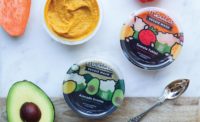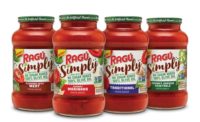2019 FOODSERVICE NEW PRODUCTS ANNUAL | SAUCES, DRESSINGS & SPREADS
Sauces, Spreads, Dressings and Condiments are Leading Ambassadors of New Flavors
Dip into Adventure: New products help operators address ethnic tastes, premium appeal, health and more.

Grecian Delight won a 2019 NRA FABI award for its reformulated new Four Pepper Cilantro Sauce. Also known as Skhug, this popular Middle Eastern condiment is made with cilantro, garlic, lemon juice and a combination of four peppers.
PHOTO COURTESY OF: GRECIAN DELIGHT FOODS (WWW.GRECIANDELIGHT.COM)

PepsiCo Foodservice earned a 2019 FABI award for its Sabra Breakfast Kits, including popular spreads.
PHOTO COURTESY OF: NATIONAL RESTAURANT ASSOCIATION (WWW.RESTAURANT.ORG)

Columbus Vegetable Oils offers nearly 30 dressings, sauces and dips in three convenient sizes of “to-go” cups for home delivery foodservice applications.
PHOTO COURTESY OF: COLUMBUS VEGETABLE OILS (WWW.CVOILS.COM)



What do trends and trains have in common? Just as you can hear a whistle or horn before the train actually comes into view, there are many early signs related to food trends. Before this year arrived, there were many signs pointing to global flavors as a key, dominant trend for 2019. And of course, sauces, spreads, dressings and condiments are the leading ambassadors of new flavors.
Last fall, the Association for Dressings and Sauces presented its top two new product awards—Dressing of the Year and Sauce of the Year—to the same company: Chelten House Products. Interestingly enough, this Swedesboro, N.J., company had adventuresome, ethnic flavors represented in its winning products: an Orange Miso Dressing and Sweet Chili Korean Style BBQ Sauce.
Last fall also brought a close the National Restaurant Association’s annual “What’s Hot?” survey of as many as 650 professional chef members of the American Culinary Federation. Global flavors ranked highly among the survey’s Top 10 trends. Globally inspired breakfast dishes claimed the fourth spot on the survey, followed by global flavors in kids’ meals. In category after category, global flavors shine brightly. African cuisines, condiments and spices trended across several categories, including items that originated in North, West and East Africa (Ethiopia). Chefs identified North African cuisine (think tajine and fuul) as today’s “hottest” global flavor.
When it specifically came to the five top condiment trends, chefs identified (1) house-made and specialty items, (2) North African condiments (dukka, zhug, harissa, ras el hanout, etc.), (3) Shichimi spice or powder, (4) Gochujang (Korean red-pepper paste) and (5) Berbere.
The foodservice research firm Technomic finds more restaurant patrons looking for authentic, ethnic food experiences. Last summer, its “2018 Ethnic Food & Beverage Consumer Trend Report” highlighted the need for accessibility, authenticity and transparency as consumers explore ethnic menu items.
“Everyone’s definition of authentic is different, so when it comes to ethnic fare, it’s vital to clarify the flavor profile and ingredients upfront so consumers aren’t surprised or disappointed in their order,” wrote Kelly Weikel, director of consumer insights at Technomic. “Additionally, ethnic options must feel accessible rather than intimidating and this can be achieved through providing flavor and sourcing information about each ethnic dish.”
Among the 87% of consumers who ever order ethnic fare or food with ethnic flavors, Technomic found that 32% would be willing to pay extra for authentic ethnic fare; 44% always prefer completely authentic fare, while 23% say their preference changes based on the cuisine. Finally, 36% of patrons replied that they like to explore regional varieties of mainstream ethnic cuisines to try new foods and flavor.
When it came it issuing its own 2019 predictions, Technomic included one called “Levitating Levantine Cuisine.”
Wrote the study authors, “Growing interest in Israeli cuisine over the past few years has led to increased flavor innovation from Israel’s surrounding countries. Specialties from Lebanon, Syria and Turkey are especially finding momentum in trendy independent restaurants. Sauces such as s’chug, pomegranate molasses, toum, labneh and tahini are finding new and innovative applications, in addition to ingredients including urfa, lavash and even schmaltz. But once exploration throughout the Levantine matures, what’s next? A likely winner, by way of Turkey as a bridge, is the Balkans.”
Eight months later, this summer indeed finds global, regional and hot flavors grabbing headlines in the world of sauces, dressings and spreads. But that’s not where the story ends. Other interesting trends include use of these products to deliver more premium experiences and health and wellness appeal. New offerings also address restaurants’ operational needs.
Flavor Adventure
Chelten House wasn’t the only company thinking about new creations featuring miso flavor. Last fall saw US Foods introduce its own Monarch private label Creamy Miso-Ginger Dressing. Made with miso paste imported from Japan, officials say the dressing “packs exotic, subtly spicy ginger notes and a wealth of versatility with the rich umami flavor.” Moreover, it’s easily used as a salad dressing, dipping sauce, marinade or glaze.
Grecian Delight Foods Inc., Elk Grove Village, Ill., earned one of the National Restaurant Association’s 2019 Food and Beverage Awards (FABI) for the company’s reformulated new Four Pepper Cilantro Sauce. Also known as Skhug, this popular Middle Eastern condiment is made with cilantro, garlic, lemon juice and a combination of four peppers (serrano, green bell, poblano, and red bell).
“Skhug was named one of the 25 most popular ingredients of 2018, representing Middle Eastern cuisine’s growing popularity among consumer. And as a fixture on flavor and sauce trends lists for 2019, Skhug capitalizes on the consumers’ trending interest in Levantine cuisine,” says Grecian Delight. “Our reformulated Skhug has been improved with a more house-made texture and appearance—but still packs the same great heat and spice and fulfills a need for authentic Middle Eastern cuisine that consumers are craving more and more.”
A different take on regional foods comes from Baltimore’s Tulkoff Food Products, which introduced a Chesapeake Sauce to the company’s foodservice flavored mayonnaise product line.
“We are a Maryland based company, we know the flavors of our Maryland foodservice operators, but we also recognize that our region’s flavor profile is recognized across the country and world and we wanted to share this. This sauce really brings the essence of what Maryland and the Chesapeake Bay flavor is all about, a sweet, salty and seafood seasoning filled sauce that is capable of going beyond crab cakes and into different menu items and dayparts,” said Ruth Madison, director of sales and marketing.
And how about a little heat to match outdoor summer temperatures. This summer saw McIlhenny Company, Avery Island, La., take its popular new Scorpion Sauce into foodservice. Already popular at retail, officials say this product—scoring at 50,000 heat units on the Scoville scale—features a blend of fresh scorpion peppers, guava, pineapple and a dash of TABASCO Original Red Sauce.
Looking for heat with an on-trend ingredient like avocado? Among those companies exhibiting at NRA’s annual Restaurant, Hotel Motel Show as Kumana Foods, a Santa Monica, Calif., company whose avocado-based sauces line includes a Habanero Mango Avocado Sauce. Other offerings include an Original flavor and a Mango Avocado variety.
Plant-Based, Better for You
Not surprisingly, Kumana Foods notes that its sauces are plant-based, vegan and crafted from six different superfoods.
Meanwhile, another NRA show exhibitor, Fora Foods, Brooklyn, N.Y., won a NRA FABI award for its FabaButter, a vegan, plant-based butter that bakes, clarifies, and browns just like dairy butter. It boasts a 360°F smoke point (considerably higher than dairy butter). Ingredients include coconut oil, sunflower oil, nutritional yeast and aquafaba, the leftover water after cooking chickpeas. Founders Aidan Altman and Andrew McClure note that aquafaba “…acts as an emulsifier in our FabaButter to blend the oils and fats and it’s an all-natural flavor and mouthfeel enhancer.”
Restaurant operators also continue to look for more clean label options. Again, among US Foods’ latest private label offerings have been a Roseli Organic Basil Pesto and a Monarch Organic Tomato Ketchup.
Meanwhile, another NRA exhibitor this year was Chicago’s 78 Brand Co., which touts that its ketchup recipe features 78% real tomatoes in every bottle. The company’s clean label, non-GMO, all natural line has expanded to include a Spicy Ketchup variety, a Yellow Mild Mustard and a Yellow Spicy Mustard.
Premium Appeal
From pesto to pate. Every year the NRA show is large enough to feature a wide range of new product options for operators.
More NRA exhibitors earned FABI awards for more premium products. They included Sabinto Tartufi (with offices in Italy and West Haven, Conn.), which created a Black Truffle Pate with black summer truffles, champignon mushrooms, porcini mushrooms, and sunflower oil in a pesto-like consistency. Since it’s already blended into a pate, this product easily allows anyone to incorporate truffles into their dishes—as a spread for canapes, a drizzle on top of pizzas, or even an addition to cream sauces.
Sevillo Fine Foods, Midvale, Utah, earned a FABI for its all natural Slow Roasted Yellow Bruschetta, a classic Italian bruschetta with an innovative twist. The company says its vine-ripened yellow tomatoes add a bright pop of color and while a proprietary roasting step contributes sweet flavor. Tomatoes are diced and tossed with the finest oil, basil, and garlic, then quick-frozen for freshness.
Another FABI winner was Sud’n’Sol, Estillac, France, for its Edamame Spread. Wrote FABI judges, “This product is a mix of edamame with a hint of mint and lemon, which results in a fresh, light, and enjoyable guilt-free spread/dip. It is a clean label product, 100% vegan, gluten-free, no preservatives, non-GMO, and made in the Bordeaux region in the southwest of France, known for its culinary specialties.”
Convenient Solutions
Still more new spreads, sauces and dressings are equally innovative—not only for flavor but for their labor-saving new form or format.
Yet another 2019 FABI award winner was PepsiCo Foodservice, which created a complete Sabra Breakfast kit, combining the brand’s popular spreads with crispy, whole grain toasts.
Notes the company, “Sabra Breakfast items are the tasty way to help fuel busy, on-the-go routines. Each tray is between 190-240 calories and provides 13g of whole grains. These morning snacks are available in two delicious varieties: Avocado Toast and Everything Hummus Toast.”
Another NRA Show exhibitor was Oregon Fruit Products, which showcased new flavors to its Fruit in Hand foodservice line. Consisting of real fruit blended to a perfectly smooth consistency, the new Fruit In Hand Harvest Apple Velvet, Cherry Velvet, Cranberry Velvet, and Pomegranate Velvet products are ready to mix into beverages, swirl into sauces or dressings, or straight from the bottle as a topping, the company says.
“We’re seeing a lot of interest from operators who want to tap into the trend of serving lower-ABV drinks and mocktails with fruit as the primary flavor profile,” said Chris Sarles, CEO at Oregon Fruit Products. “High-antioxidant fruits like pomegranate and cranberry are particularly of interest, as more consumers look to get the most nutritional impact from their food and beverages. It would take a significant amount of time and effort for foodservice and bar staff to prep this kind of puree and achieve a level of consistency from drink to drink, so Fruit In Hand saves them valuable time and labor costs.”
Offering another sweet solution is Nestlé Professional, which created a ready-to-eat Nestlé Toll House Chocolate Chip Cookie spread. Officials say the spread features 100% Nestlé Toll House real chocolate morsels and has no artificial colors or preservatives. Applications include mixing it into baked goods or frozen treats, adding it as a topping for waffles and other hot foods, and serving it on the side as a dip.
“We’re helping our customers evolve their menus and create innovative treats with our unique product,” said Gina Tohme, Nestlé Professional Marketing Manager, Branded Foods – Desserts and Handhelds. “It’s amazing to see how Nestlé Toll House Chocolate Chip Cookie Spread transforms from scoopable when frozen to spreadable when refrigerated—it even melts when it’s served on something warm. Its buttery taste puts a new twist on our beloved chocolate chip cookies, and it’s a crave-worthy ingredient that can attract cookie lovers.”
Last but not least, processors also are addressing the growing food delivery trend. One of them is Columbus Vegetable Oils, Des Plaines, Ill., which created a line of dressing cups for foodservice and convenience store operators.
The dressing cups, which are available in three sizes—1.2-ounce, 1.5-ounce and 2-ounce—are filled with dressing from Columbus’ Butcher Boy line. With nearly 30 dressings, sauces and dips to choose from, the cups are a solution for operators looking to offer individual portions of condiments to customers.
“The delivery and food on-the-go trend is not only growing, it is also becoming a table stake within many of our customers’ operations,” said Ben Caffrey, operations manager for Columbus Vegetable Oils. “We are always looking to stay in tune with what our customers’ needs are, which is a large reason for the launch of the dressing cups. It’s important that we are able to produce a necessary product for our clients to succeed.”
Looking for a reprint of this article?
From high-res PDFs to custom plaques, order your copy today!








